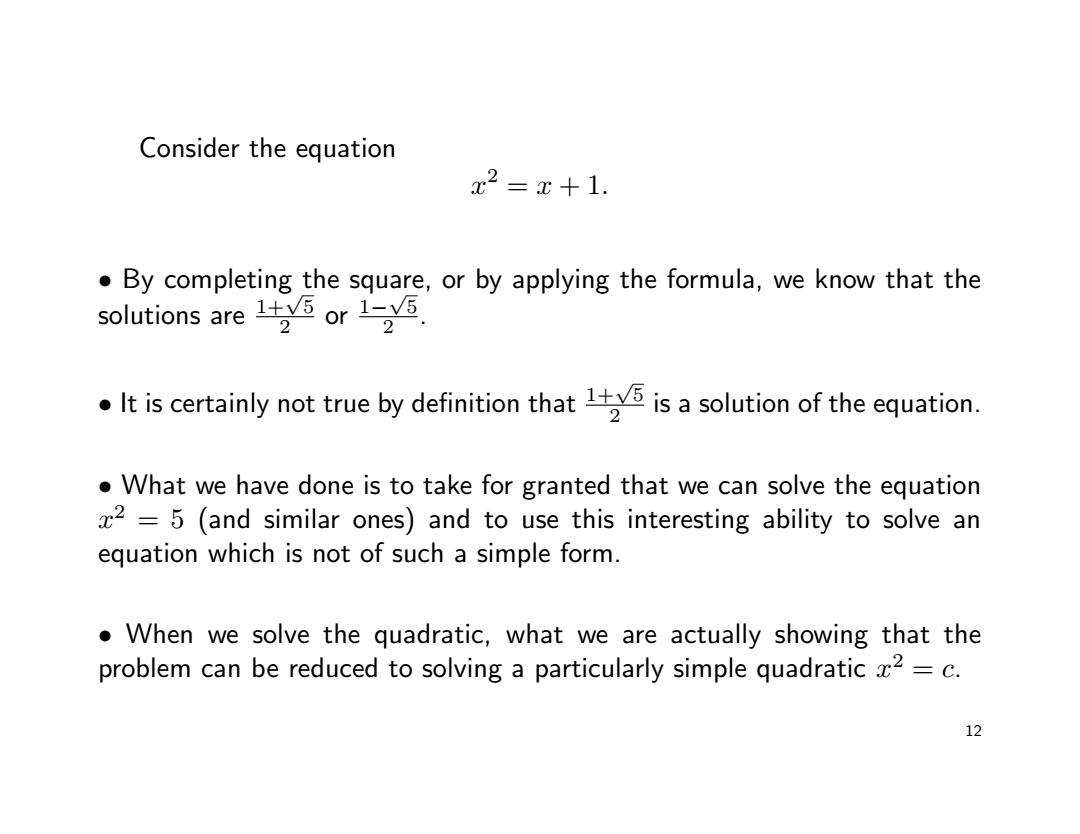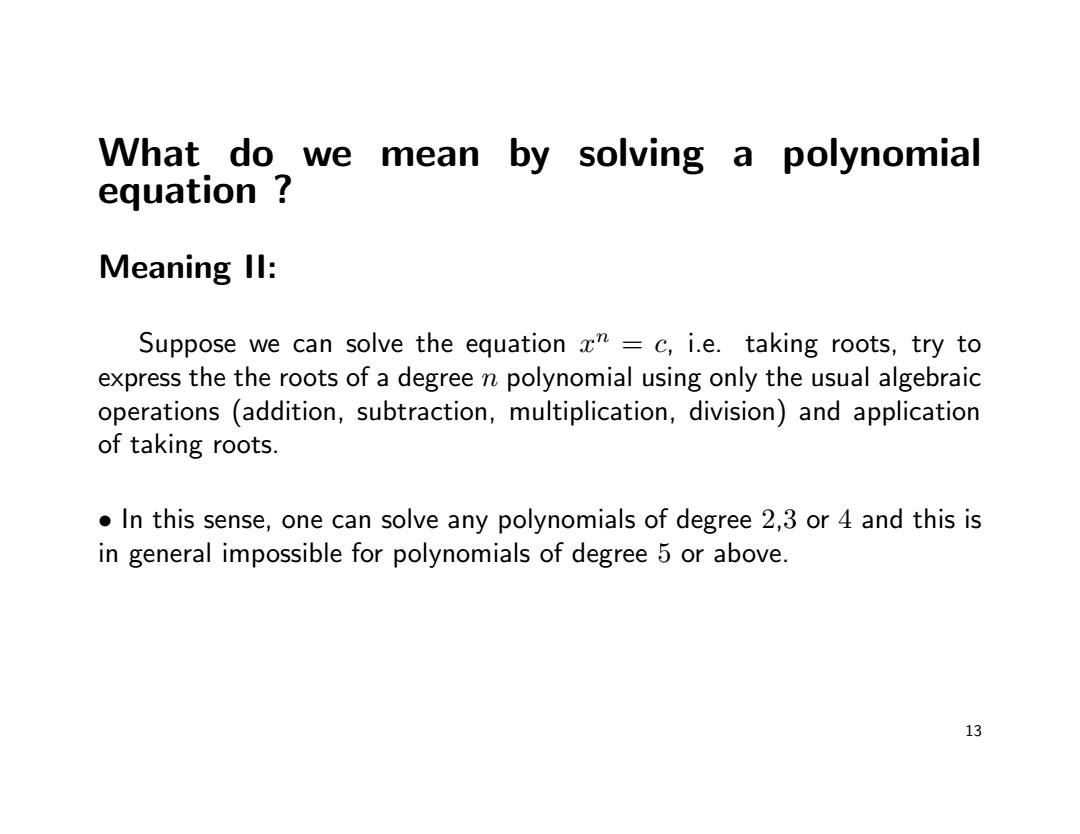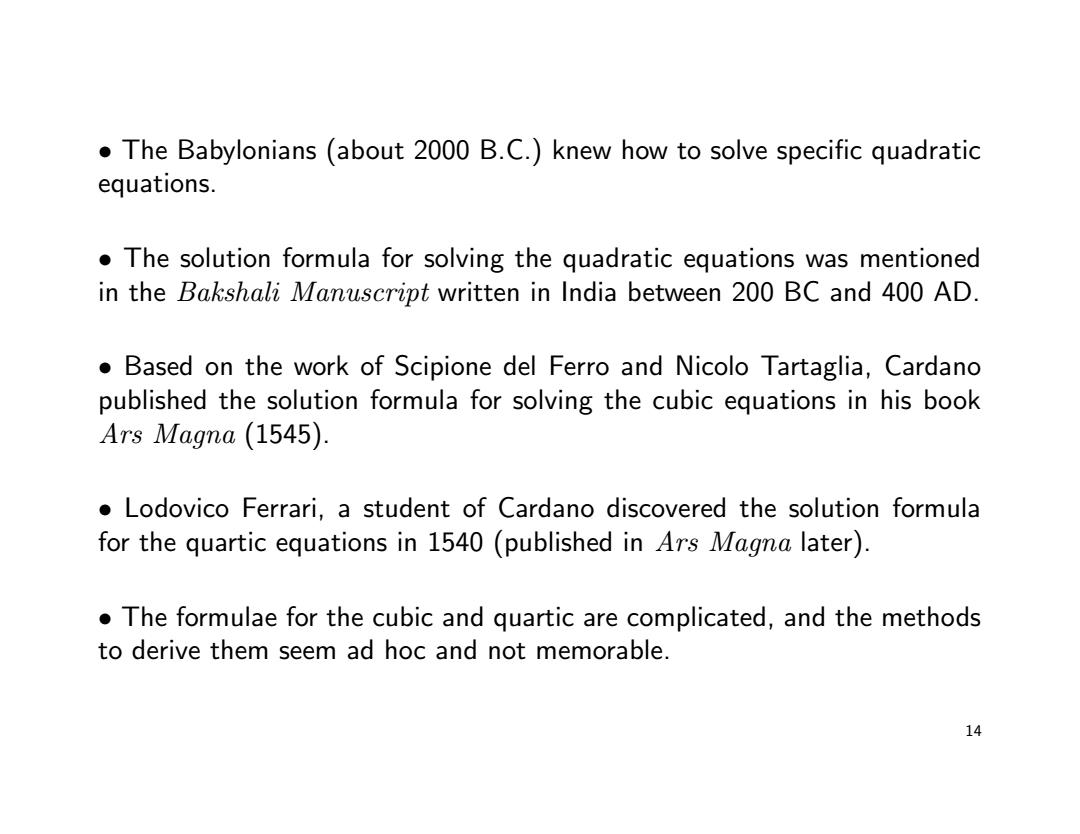
Example 2.Solve the equation z2=5. x2 =5 x2-5 =0 (x-V5)(x+V5) =0 =50r-vV5 C ●But what is√5?Well,V5 is the positive real number that square to5. We have "learned"that the positive solution to the equation z2-5 is the positive real number that square to 5 !! So there is a sense of circularity in what we have done here. Same thing happens when we say that i is a solution of x2=-1. 10
Example 2. Solve the equation x 2 = 5. x 2 = 5 x 2 − 5 = 0 (x − √ 5)(x + √ 5) = 0 x = √ 5 or − √ 5 • But what is √ 5 ? Well, √ 5 is the positive real number that square to 5. • We have ”learned” that the positive solution to the equation x 2 = 5 is the positive real number that square to 5 !!! • So there is a sense of circularity in what we have done here. • Same thing happens when we say that i is a solution of x 2 = −1. 10

What are "solved"when we s solve t these equations The equations z2=5 and x2=-1 draw the attention to an inadequacy in a certain number system (it does not contain a solution to the equation). One is therefore driven to extend the number system by introducing,or adjoining',a solution. Sometimes,the extended system has the good algebraic properties of the original one,e.g.addition and multiplication can be defined in a natural way. ·These extended number systems(eg.Q(V5)={a+bW⑤la,b∈Q}or Q(i))have the added advantage that more equations can be solved. 11
What are “solved” when we solve these equations ? • The equations x 2 = 5 and x 2 = −1 draw the attention to an inadequacy in a certain number system (it does not contain a solution to the equation). • One is therefore driven to extend the number system by introducing, or ‘adjoining’, a solution. • Sometimes, the extended system has the good algebraic properties of the original one, e.g. addition and multiplication can be defined in a natural way. • These extended number systems (e.g. Q( √ 5) = {a + b √ 5|a, b ∈ Q} or Q(i)) have the added advantage that more equations can be solved. 11

Consider the equation x2=x+1. By completing the square,or by applying the formula,we know that the solutions are 15 or 15 2 2 It is certainly not true by definition that5 is a solution of the equation. 2 What we have done is to take for granted that we can solve the equation z2=5 (and similar ones)and to use this interesting ability to solve an equation which is not of such a simple form. When we solve the quadratic,what we are actually showing that the problem can be reduced to solving a particularly simple quadratic x2=c. 12
Consider the equation x 2 = x + 1. • By completing the square, or by applying the formula, we know that the solutions are 1+√ 5 2 or 1− √ 5 2 . • It is certainly not true by definition that 1+√ 5 2 is a solution of the equation. • What we have done is to take for granted that we can solve the equation x 2 = 5 (and similar ones) and to use this interesting ability to solve an equation which is not of such a simple form. • When we solve the quadratic, what we are actually showing that the problem can be reduced to solving a particularly simple quadratic x 2 = c. 12

What do we mean by solving a polynomial equation Meaning Il: Suppose we can solve the equation xT=c,i.e.taking roots,try to express the the roots of a degree n polynomial using only the usual algebraic operations (addition,subtraction,multiplication,division)and application of taking roots. In this sense,one can solve any polynomials of degree 2,3 or 4 and this is in general impossible for polynomials of degree 5 or above. 13
What do we mean by solving a polynomial equation ? Meaning II: Suppose we can solve the equation x n = c, i.e. taking roots, try to express the the roots of a degree n polynomial using only the usual algebraic operations (addition, subtraction, multiplication, division) and application of taking roots. • In this sense, one can solve any polynomials of degree 2,3 or 4 and this is in general impossible for polynomials of degree 5 or above. 13

The Babylonians (about 2000 B.C.)knew how to solve specific quadratic equations. The solution formula for solving the quadratic equations was mentioned in the Bakshali Manuscript written in India between 200 BC and 400 AD. Based on the work of Scipione del Ferro and Nicolo Tartaglia,Cardano published the solution formula for solving the cubic equations in his book Ars Magna (1545). Lodovico Ferrari,a student of Cardano discovered the solution formula for the quartic equations in 1540(published in Ars Magna later). The formulae for the cubic and quartic are complicated,and the methods to derive them seem ad hoc and not memorable. 14
• The Babylonians (about 2000 B.C.) knew how to solve specific quadratic equations. • The solution formula for solving the quadratic equations was mentioned in the Bakshali Manuscript written in India between 200 BC and 400 AD. • Based on the work of Scipione del Ferro and Nicolo Tartaglia, Cardano published the solution formula for solving the cubic equations in his book Ars Magna (1545). • Lodovico Ferrari, a student of Cardano discovered the solution formula for the quartic equations in 1540 (published in Ars Magna later). • The formulae for the cubic and quartic are complicated, and the methods to derive them seem ad hoc and not memorable. 14